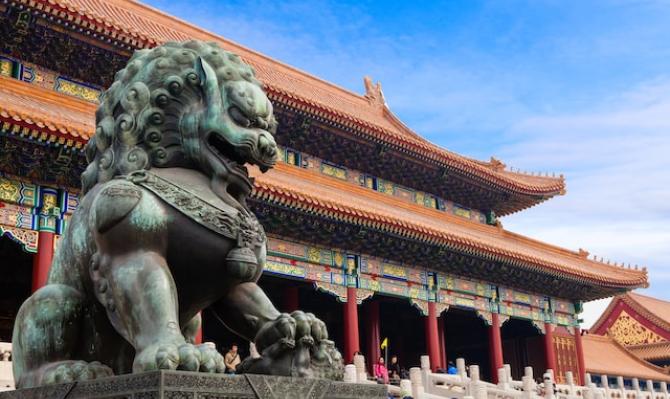The Middle Kingdom and its neighbours (part I): a geo-economic perspective
In this two-part study, we look at how China has become the centre of gravity of Asian value chains in recent decades and how this has affected trade flows in the surrounding countries, and in particular those of ASEAN member states.

The meaning and use of the name of the country we know today as China evolved over time. Its most common name, used for the past few centuries and which today is the country’s official name in Mandarin, Zhongguo, means Middle Kingdom.1 In addition, China’s economic relations with the outside world have also changed over the centuries, going through periods of practical isolation from the outside, periods of high tensions, such as during the Opium Wars, and a period of reopening, since the 1970s. In previous Focuses2 we have seen how the Asian giant has gained importance in global value chains, surpassing for the first time in 2021 the figure of 3 trillion dollars in exports of goods. The same happened in the opposite direction: the Chinese market has gained importance for most of its trading partners and neighbours. Focusing on Asia, China is the destination for a quarter of South Korea’s exports, a fifth of Japan’s exports and a sixth of those of ASEAN countries.3 Two major trends have also emerged in this century: the decline of Japan’s manufacturing sector and the growing central role of China in Asian value chains.
- 11. The western name China (or Sinae in Latin) originates from the name Qin (pronounced «chin»), the state which expanded in the upper Yellow River region beginning in the 7th century BC and then emerged as one of the dominant powers of the Seven Warring States, unifying them and establishing the first empire of unified China, under the Qin dynasty, in the 3rd century B.C. See, for example, L.S.K. Kwong (2015) «What’s in a name: Zhongguo (or ‘Middle Kingdom’) reconsidered», The Historical Journal, 58, 3, pages 781-804. Cambridge University Press.
- 2See the Focuses «EU and China: mapping out a strategic interdependence (I and II)» in the MR05/2022 and the MR01/2023.
- 3The ASEAN countries include Brunei, Cambodia, the Philippines, Indonesia, Laos, Malaysia, Myanmar, Singapore, Thailand and Vietnam. Among these, the largest exporters are Vietnam, Singapore, Malaysia, Thailand and Indonesia.
Recent developments in Asian value chains: the case of ASEAN countries
In 2021, exports of goods from ASEAN countries to the rest of the world reached 1.4 trillion dollars (compared to 1.3 trillion for USMCA countries and 2.5 trillion dollars for EU countries, to cite other major trading blocs of a continental scope).4 Globally, including intra-bloc trade flows, the ASEAN region accounts for 8% of global trade, compared to almost 30% in the case of the EU or 12% for USMCA. Looking at the breakdown by sector, almost 40% of ASEAN exports to the rest of the world today correspond to electronics and machinery. A decade earlier, exports from these countries to the rest of the world amounted to 900 billion, with 30% of the total corresponding to these high-tech sectors (at that time, mining and derivative products occupied a prominent second place, with 17% of total exports, compared to 8% today). The Economic Complexity Index (ECI) developed by the Observatory of Economic Complexity (OEC) measures the «technological intensity» of each economy according to the profile of its exports, and it places Singapore in 6th position in global terms, Malaysia in 24th and Vietnam in 58th (in 2010, Singapore was in 11th place, Malaysia in 29th and Vietnam in 78th).5 Trade flows in the ASEAN bloc have also been changing course, with greater concentration in China and the US and a loss of importance on the part of Japan. Thus, China and the US each account for around 20% of ASEAN exports (around 15% in 2010), while Japan’s share went from 13% in 2010 to 8%.
The first table represents the map of ASEAN countries’ integration into global value chains, measuring the value added that originates in these countries as a proportion of the total exports of each sector-country. For instance, for every 100 euros of exports of the European electronics sector, 1.2 euros originates in ASEAN countries (compared to 81 euros produced in the EU itself, 4.1 euros in China and 3.4 euros in the US). On the other hand, 1.8 euros out of every 100 of China’s manufacturing exports originates in ASEAN countries (compared to around 82 euros in China, 2.3 euros in South Korea and in the EU, 2 euros in the US and 1.8 euros in Japan).6 Also, we can see how ASEAN countries have gained prominence in the global manufacturing sector, particularly in more cutting-edge sectors. Moreover, not only has the ASEAN bloc exported more abroad directly (as we can see by analysing the gross export data), but also, through its greater integration into the Asian and European value chains, it has benefited from its pull effect and has exported more indirectly to third countries.
- 4The United States-Mexico-Canada Agreement (USMCA), which substituted the North American Free Trade Agreement (NAFTA), governs a free trade zone encompassing these three countries. If we add trade between countries of the same bloc, then ASEAN countries export a total of around 1.7 trillion dollars, USMCA countries around 2.6 trillion dollars and the EU, some 6.2 trillion.
- 5For reference, Japan ranks first, Germany fifth, the US is in tenth position and China is 25th.
- 6At the turn of the century, ASEAN countries accounted for 2% of the VA of China’s manufacturing exports, compared to 75% in China, 3% in the EU, in the US and in South Korea, and around 5% in Japan.

On the other hand, ASEAN countries have also adjusted their production chains. Most notably, Japan has been displaced by China in the regional value chain (see first chart), a «stylised fact» that extends to other Asian economies.7 In fact, there is a general shift in the «centre of gravity» of value chains towards China, and this also affects other trading partners, such as the US. Finally, it should be stressed that there are important differences between ASEAN countries. In the Focus «The Middle Kingdom and its neighbours: two case studies», in this same report, we analyse the recent experiences of Vietnam and Malaysia in greater detail.
- 7Not only has Japan lost market share in the region, but manufacturing exports to ASEAN countries, China, South Korea, Taiwan and even the US have fallen in absolute terms. At the same time, there has been a decrease in the percentage of the «domestic» VA (i.e. produced in Japan) in the country’s gross exports. However, we cannot talk of Japan decoupling from Asian (or global) value chains, given that other countries (or groups of countries) have increased their presence in Japanese value chains.

What does the future hold for Asian value chains?
In recent decades, China has acquired an indisputable economic role, which in turn has benefited many Asian economies. However, as it has claimed a geopolitical role proportional to its economic might, tensions have increased with some of its most important trading partners, and this could lead to significant side effects for its economic relations. Will China remain the Middle Kingdom in global value chains? How will its neighbours manage to position themselves in the new geopolitical environment?
While Asia has taken on a crucial role in global value chains, the continent (and, in particular, the Pacific region) is becoming the epicentre of the geopolitical dispute between blocs. The fragmentation of global trade, coupled with China’s economic slowdown, will thus bring major challenges to the entire region and, in particular, to the ASEAN countries. Still, there are grounds for optimism. We have seen, for example, how, although China has become the centre of the Asian value chain, ASEAN countries have maintained (and even strengthened) their economic relations with the rest of Asia and with other regions of the world. On the other hand, it should be recalled that, among these countries, some assume geopolitical positions that are closer to China, while others are closer to the US and others maintain a certain «strategic» ambiguity. It is feasible, therefore, that new de-risking strategies on the part of the emerging geopolitical blocs (potentially one that is closer to the US and another to China) could end up generating winners, in particular countries that are geographically located closer to both blocs and those which have certain essential resources (whether natural or technical).8 Greater economic fragmentation could thus materialise in the form of longer value chains, in which parts of the production process (such as assembly or the production of certain intermediate goods) have to be relocated to regions considered «neutral» with certain competitive advantages. ASEAN countries are among those which, due to their geography and comparative advantages, could even end up benefiting from a more uncertain environment. On the other hand, other countries, such as India, are positioning themselves so as to «hedge their bets» in this geopolitical context, with the possibility of becoming an important trading partner for the region. But of course, no kingdom in the middle will be able to thrive on its own.
- 8See, for example, R. Campos, J. Estefania-Flores, D. Furceri and J. Timini (2023). «Geopolitical fragmentation and trade». Journal of Comparative Economics (published).
